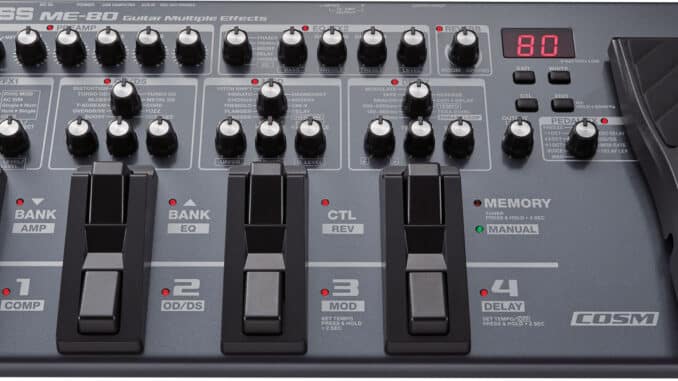
Guitar technology has come a long ways, especially in the effects world. From stompboxes up to digital amplifiers, the evolution is always evolving. By the time you buy the latest-and-greatest effects processor, to the time it gets delivered to your door step… to the time you get it unboxed… manual read… and plugged in, two generations of newer/better Multi-Effect processors have been released. You can never keep up with technology! That said, old guitar equipment is still good. There’s no reason why you should try to stay up-to-date with the new coolest and latest piece of equipment, you’ll just go nuts (and broke) trying. Forget that, jump on Craigslist right now and look for these following Boss ME pedals — Let’s take a walk through these different generation Boss ME Mutli-Effects pedals that you can buy cheap.
- Boss ME-25
- Boss ME-30
- Boss ME-70
- Boss ME-80
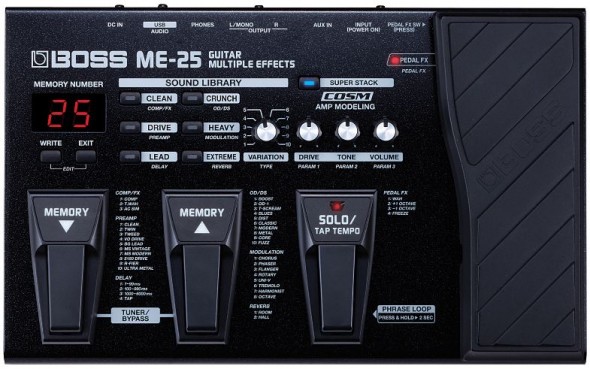
Boss ME-25 Multi-Effects Processor
BOSS is proud to announce the addition of the ME-25 Guitar Multiple Effects processor to its popular line of floor-based multi-effects. The compact and durable ME-25 inherits its high-quality sounds from the flagship ME-70, and packs a ton of BOSS tone tools into one amazingly affordable package.
Sporting a quick and easy user interface for professionals and newcomers alike, the ME-25 features a full compliment of COSM amplifier models. The onboard Sound Library comes loaded with 60 effects combinations suitable for a wide range of playing styles. The ME-25 runs on six AA batteries or AC power, and its portable size makes it ready to rock anywhere.
The ME-25 is stocked full of the best BOSS effects — distortions, overdrives, modulation effects, Delay, Reverb, Harmonist, and many more. The built-in expression pedal controls a number of pedal effects, including wah, octave up/down, and a unique freeze effect. Three heavy-duty footswitches allow the user to select sounds and perform other functions, such as accessing the built-in tuner, tapping in delay times, and enabling the SOLO feature.
The ME-25 is the first multiple effect processor at this price point to include BOSS’ renowned COSM amp-modeling technology. There’s a range of classic amps from clean combos to raging stacks, along with a Super Stack function that gets big amp tone from a small practice amp. A 38-second looper is also included for real-time sound-on-sound recording.
The ME-25 also includes USB connectivity, allowing users to stream audio and other data back and forth with their computer. A powerful librarian is available as a free download to manage sounds, and the ME-25 is bundled with Cakewalk SONAR 8.5 LE for multi-track audio and MIDI recording. Check for price.
Boss ME-25 Video Demo
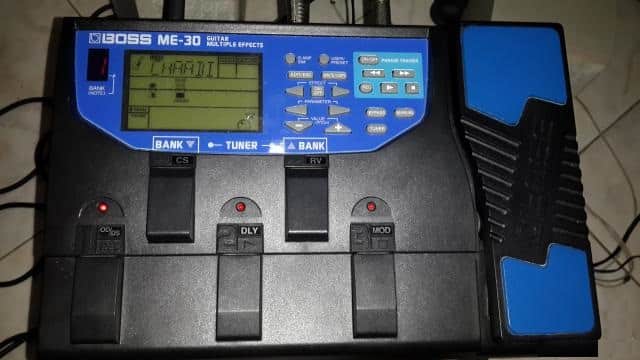
Boss ME-30 Guitar Multi-Effects Processor
Though the size of floor multi-effects processor is decreasing, the features and capabilities of these units continue to grow. Although the Boss ME-30 is only slightly larger than an average hard-bound book, it can create a multitude of sounds that once could only be achieved with a huge rack and a gaggle of stomp boxes. Add in sampling capabilities and you’ve got a serious contender in the maximum banger-per-buck race.
The ME-30 packs 16 different effects into its small frame. You can use up to nine of them at once, and any one of four can be assigned to the built-in expression pedal. The ME-30 comes loaded with 30 factory presets, and the large, user-friendly LCD dispay makes loading in another 30 of your own an easy task.
On board you’ll find some very flexible effects and sound-sculpting tools, including compression, seven types of overdrive and distortion, a three-band equalizer, phaser, noise gate, digital delay with up to two seconds of delay time, chorus, flanger, pitch shifter, tremolo and reverb.
The pedal-assignable effects consist of volume, wah, “tremolo arm” (similar to a Whammy pedal) and ring modulator. There’s a global guitar amp simulator that emulates an amplifier’s tone when you’re playing through headphones or recording direct to tape/cd/hardrive. And in addition to all these effects, the ME-30 has a built-in chromatic tuner.
What really sets the Boss ME-30 apart from most other multi-effects pedals, however, is its value as a learning tool. It has an auxiliary input, which allows you to plug in a CD or tape player, put on your headphones and jam along. When you get to a part you just can’t figure out, put the ME-20 into “phrase trainer” mode and sample up to 12 seconds of the recorded music. You can loop it and slow it down to as much as ¼ the original speed without altering the pitch, allowing you to analyze the 32nd-note run with the greatest of ease.
The Boss ME-30 is also exceptionally well suited for use in home studios. Many functions are accessible only with the keypad, but most of the ones you might want to access in live performance, such as the sampling function, are accessible via foot control. The LCD is unlit, but it glows in the dark for several hours when exposed to light for a brief period. A bright single-digit LED displays which bank of settings you’re in, but whether this is a factory preset or your own creation is shown only in small letters on the LCD.
Anyone familiar with Boss’ excellent array of stomp box flavors will love the ME-30’s sounds. The flanger is particularly good, and the ring modular (a metallic, industrial timbre that can turn the simplest phrase into wickedly unrecognizable bleeps, squeals and grunts) is a welcome surprise, especially when you consider that most ring modulators available today cost as much as this entire unit.–discontinued product. Debate: Stomp Box vs. Multi Effects Processor.

Boss ME-70 Guitar Multi-Effects Processor
Boss ME-70 is a floor-based processor that offers the compact design and simplicity of a stompbox. With dedicated knobs for each section, a new, high-quality COSM engine derived from the GT-10, and added EZ Tone and Phrase Loop features, the ME-70 is the ultimate easy-to-use floorboard powerhouse.
In addition to its superb Overdrive/Distortion section, the ME-70 now features a new Preamp section with the latest sound-modeling COSM engine for the most natural response and sound quality. The ME-70 is made to play, and the hardware now adds a fourth footswitch for even more real-time effects control.
The ME-70’s dedicated knobs for each effect section allow full, fast control over sound creation, just like a stompbox. The knobs make the ME-70 incredibly easy to use compared to traditional multi-effects units. Users will also love the new Phrase Loop function for sound-on-sound creation, with up to 38 seconds of recording time. Its EZ Tone function allows for fast and easy tone creation via simple effects presets, so players of any level can create superb tones of any genre within seconds.
With a friendly design and unprecedented tone creation capabilities via COSM and EZ Tone, the ME-70 will be an essential live performance piece for guitarists. Plus, it will bring a diverse array of world-class COSM tones to any studio recording.
- Dedicated knobs for each parameter for fast, friendly operation
- New COSM Preamp section derived from GT-10 and Legend series
- EZ TONE for quick, easy editing
- Four footswitches and Expression pedal
- PHRASE LOOP function in DELAY section, with 38 seconds of recording time
Amazing amps, preamps, and FX
In addition to its stellar COSM amp models and effects, the ME-70 is fitted with a new COSM Preamp section derived from BOSS’s GT-10 and Legend series. With the ME-70 you can dial up a world of tone, from classic to cutting-edge, with simplicity and speed.
Stompbox ease
It’s powerful and potent, yet the ME-70 offers the ease of a stompbox. The simple knob-based controls for each effect section makes dialing in tone easier than ever, especially with the innovative EZ Tone feature. And when you want to kick in an effect, just step on one of the four footswitches. Think of it as an array of stompboxes melded into one convenient pedalboard.
Phrase Looper
The ME-70’s Delay section is equipped with a dedicated Phrase Looper, which offers a lengthy 38 seconds of recording time. Play a riff, capture and loop it, and solo over it, all in real-time onstage. Amaze your audience with live multi-layered magic.
Extra Expression
Breathe life into your performances with the built-in Expression Pedal. Simply dial up one of the six pre-programmed pedal-control destinations (Wah, Voice, Octave 1, Octave 2, Mod Rate, and Delay Level), put your foot down, and express yourself. For more information, visit Boss’s official website at www.bossus.com.
Boss ME-70 Video Demo
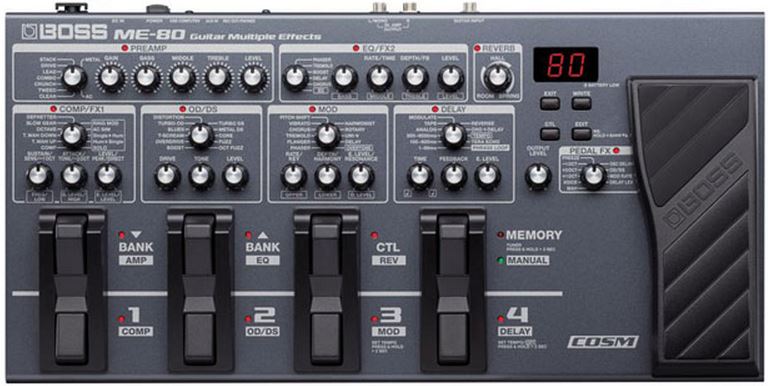
Boss ME-80 Multi-Effects
A lot of old-school guitarists will turn tail and run at the sight of a multi-effects unit. But multi-effect fear isn’t altogether irrational, because, let’s face it, a lot of multi-effect pedals and rack units are bears to work with, especially when time is short and you just want to plug in and play.
With the new ME-80, however, Boss clearly prioritized ease of use, and this surprisingly utilitarian, powerful, and portable unit is relatively simple to operate, a lot of fun, and great for home demo studios, small, informal gigs, and even unorthodox tinkerers who like the straightest possible line to the most possible sounds.
Tough, Easy to Toss Around
The ME-80 is built for moving from place to place fast, and while it’s not super-light, it’s sturdy as hell, with an almost entirely metal enclosure and chassis. Apart from the knobs and switches, there’s very little plastic.
You can also power the ME-80 with six AA batteries, which means you can pick it up and move from room to room, or go from jamming through headphones in the kitchen to blasting through your amp—all with the uncomplicated glee of a kid toting around his battery-powered keyboard. If you’re a busker, play pub gigs, or perform at the farmer’s market, this kind of portability can be invaluable.
The addition of USB connectivity maximizes the creative potential of the ME-80 too. Once you’ve downloaded the ME-80 software, you can literally be writing a riff with the device in the backyard and capture the same sounds on your DAW up in your office a few minutes later.
Obviously, the ME-80 isn’t the first multi-effect unit or modeler to deliver portability and connectivity. Devices like Line 6’s POD and Boss’ own GT-100 have similar capabilities, and the ranks of tablet- and smartphone-based guitar interfaces seem to grow daily. But the ME-80 offers an interface that’s much more familiar and intuitive to the typical stompbox user, and arguably, a whole lot more fun to play with than other devices.
For starters, the ME-80’s interface is basically a little hive of stompboxes. Each of the four footswitches closest to the guitarist is a bypass switch dedicated to one of four effects groups: compression and FX1 (which includes a ring modulator and acoustic simulator among others), overdrive and distortion, modulation, and delay (which also includes a looper). Three footswitches above and to the left of the four main effect switches activate a preamp simulation section, an EQ/FX2 section (which also includes a second phaser, delay, and looper), and a reverb control.
Each effects group has a dedicated set of knobs, including one that selects a specific amp or effect type. To the right of the footswitches, there’s an expression pedal for operating pedal effects (wah, talk box, Whammy-style octave up and down functions, and more). You can also use the pedal as an expression pedal to control modulation rates and delay level.
The two leftmost pedals in the top row also let you select presets when in “memory” mode, which is activated by the upper right switch. There’s a raft of cool factory presets. But creating your own is a straightforward, three-step process.
Sound Horizons
The sounds inside the ME-80 range from really good to passable, depending on the effect or amp. Some voices, sounds, and effects—the “tweed” amp, the delays, and the tremolo effect—have a warm, organic quality and relatively natural dynamic response. Others—heavy phase settings, the ring mod, and most of the heavy distortions—more readily betray their digital roots.
The effects typically put function before freak-out potential: There’s few deep, ambient space verbs and fractured delay sounds to be found here. Still, with a bit of tinkering and an adventurous spirit you can create a lot of unusual, recording-worthy textures, and the right pairings can make the ME-80 sound very lush.
Mating the rotary effect and the spacious and spacey “tera echo” delay along with a sustain-heavy compressor and a Vox-like combo-amp simulation generates an expansive, swirling, sci-fi/psychedelic tapestry. The “harmonist” (which can be set for thirds, fourths, fifths, sixths or an octave above and below) and a little boost and tape echo will make you sound like Duane and Dickey without the expense and hassle of a second guitarist.
There are some peculiarities to get used to on the ME-80. For one thing, you have to keep effect levels for modulation and delay effects uniform with OD and comp effects if you’re using more than one effect. For example, if you’re about to launch into the Uni-Vibe segment of raging Hendrix solo and the “uni-v” effect level is too low, you’ll experience a highly anti-climatic signal cut for the whole effects chain rather than for just the selected effect level. This type of signal cut might makes sense when you’re trying to keep a hot fuzz in check, but it makes less sense for other effects. The workaround is to create a preset. But if you prefer to play without them you have to be careful about effect balance.
The End Line
The features covered here represent just a fraction of what the ME-80 can do. And while the ME-80 is not without limitations (most often these are fair tradeoffs for simplicity), it’s a smart, streamlined way of getting a lot of sounds for very little dough.
Some sounds, like the delays, combo, and tweed amp voices are a real pleasure to use and have a relatively organic feel. Others—most notably the high-gain distortions—exhibit a more digital edge and lack the touch and reactivity of the genuine article. The unit definitely sounds best when paired with a tube amp with a neutral EQ setting. But cleaner sounds are effective with a good PA when you use the internal speaker simulator and dial up a sweetening EQ that massages highs and mids.
The real magic of the ME-80 is it’s ability to deliver so many reasonably convincing sounds in a sturdy package you can power with a pack of AAs or DC adaptor. That means a wealth of possibilities for remote performance and production. If all you have is a set of headphones, you can practice anywhere. Hook the ME-80 up to a battery-powered amp and you can play for the rest of the world at any location—say, jams on a mountaintop—with all the functionality of a traditional, familiar pedalboard.
Taken together, the ME-80 is a set of smart design compromises in a multi-effect unit so affordable and easy to interact with that it rarely feels like any kind of compromise at all. Review credit: www.premierguitar.com


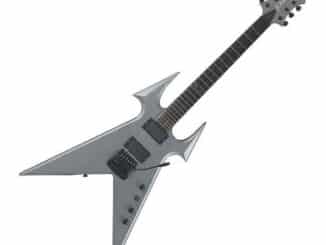
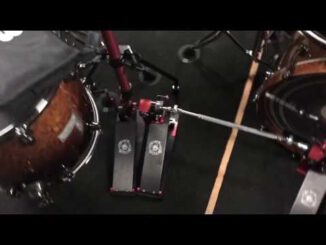

I am looking for the operator/instruction manual for the BOSS ME-30. Any assistance would be MOST appreciated. I AM NOT looking for a free bee. I’m willing to pay a reasonable price, but I cannot find the manual that came with it and would like to find the manual.
i have a pdf ver of ME30 , if you like. i got it free so i can send you a copy . let me know.
Hey mahesh, Ive been looking for the manual for the ME-30, I would very much appreciate if I can get a copy of the via email, please lete know, thanks!
Surely , pls let me know your email address
I am a guitarist and I often use the BOSS ME-80 to produce sounds. It is very good at effects processing and it has an awesome sound. The program is easy to operate and there are many useful features that can be used in music production, such as tone shaping, delay time control, level adjustment (reverb), etc.
The ME-80 is on sale everywhere for $279 right now (November 2022). I’m wondering if BOSS is preparing for a rollout of a successor. Any thoughts?
How many efx can you combine at the same time on this multiFX i.e. chorus+compressor+delay +phaser as like a daisy-chain of stompbox’s all connected together in/on a pedalboard or what have you.Have tried tooo get a crystal clear cut answer tooo this question¿bcos there’s nothing in the manual that indicates whether it can or it can’t or how¿None of the answers or explanations given or received seem tooo sufficiently address this matter concisely orif it’s even possible would like know tooo any help is greatly appreciated thanx folks
Correction needs to be made: it is a vibrato bar, NOT a blooyd tremolo bar.
Hello everyone,
I’ve got a Boss ME-33 and i really like it a lot but lately been feeling like the Boss ME 25 is a lot better. Pls is my observation correct